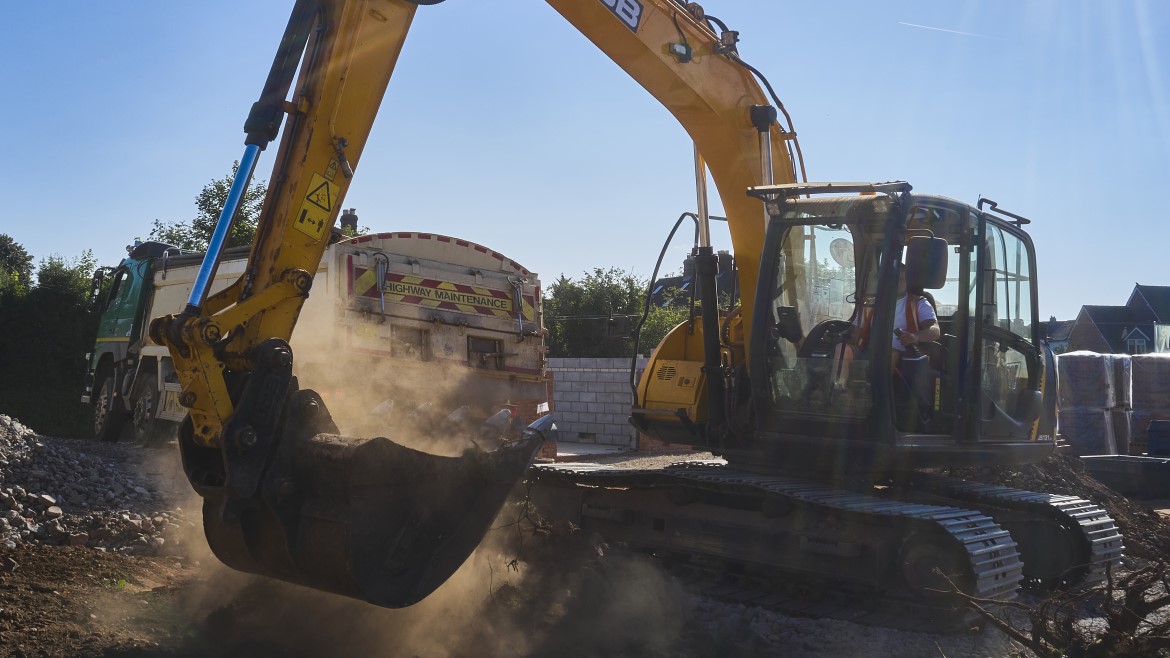Oct 12, 2021
Posted by Adrian Fitzpatrick, Commercial Manager, Viscosity Modifiers, Matt Thom, Project Manager - Industrial Specialties
This article highlights the key takeaways from our recent Global Hydraulic Fluid Market Trends webinar, part of our Lubrizol360 Webinar Series featuring Lubrizol experts discussing important industry trends.
The global hydraulic fluids market represents significant opportunity for the overall lubricants industry. Consider that the overall size of the hydraulic equipment market, spanning Asia Pacific, Europe and the Americas regions, has risen to approximately $77.5 billion in 2021. It’s expected to continue rising at a compound annual growth rate (CAGR) of 4.13% to 2024.
To seize the opportunities available for lubricant manufacturers here, it’s important to be cognizant of some of the trends and challenges that exist within the hydraulic fluids market today and tomorrow. Here’s what you need to know:
Market Overview
The global hydraulics equipment marketplace is broken down into two primary segments: industrial equipment, accounting for approximately 35% of the market, and mobile hydraulics, representing 65% of the market and the bigger opportunity for lubricant providers.
Importantly, however, the growth of the hydraulic lubricant market does not quite match the growth pace of the broader hydraulic equipment market. This is a clear reflection of the ongoing trend in reducing oil sump volumes and extending oil drains to minimize operating costs for end users of these machines. A few other points of note include:
- Mineral oil formulations continue to dominate the market here due to their cost-effectiveness
- Group II base stocks are gaining share as Group I base stocks become more phased out globally
- The market is seeing approximately 8% growth in bio-hydraulic lubricants, reflecting the broad global push toward a more sustainable, cleaner future
Hydraulic Equipment Trends
Hydraulic equipment—like many applications for lubricants in general—is changing rapidly. New technologies are enabling more efficient hydraulic equipment operation, and this has implications for the lubricant solutions that help them run reliably. Some of the most important trends include:
Increasing power density and internal pressures. Hydraulic systems are being designed to be lighter and more power dense to help them compete with electric systems that are gaining traction in the marketplace. Additionally, weight-saving measures to help reduce fuel consumption in mobile applications further drive the market towards smaller pumps that do not compromise on power. As a result, these systems operate under much higher internal pressures, which can be as high as 450 bar in current mobile equipment and is likely to only grow higher.
However, with higher and higher pressures, the potential for internal fluid leakage increases—this can lead to a reduction of the clearances between moving parts, a major problem in terms of machine durability. Lubrication in these applications has thus moved from hydrodynamic into the mixed film region, requiring high-performance additives to help best protect component parts.
Minimized power loss. Modern hydraulic systems are designed to reduce power losses and increase overall machine efficiency. To accomplish this, equipment designers have reduced the number of bends, joints and filter differentials, and minimized valve losses. Even the smallest energy savings are beneficial, and original equipment manufacturers (OEMs) have begun to further investigate how energy-efficient hydraulic fluids can contribute.
Finer filtration. Hydraulic pumps are very sensitive to contamination. Increased pressures and decreased clearances in valves and pumps require the fluid to be ultraclean. Finer filters are being specified to keep fluids clean, with cleaner ISO 4406 test levels required. Wet filterability is also an essential fluid performance parameter, a hydraulic fluid’s resistance to filter-clogging dropout through incubation with water is tested thoroughly during a development. Filters have also increased dirt-holding capacity, and glass fibers in the filter increase surface area but generate more static.
Smaller oil coolers and reservoirs. Modern equipment design minimizes the size of the oil coolers and reservoirs to save space and reduce weight. This can increase the hydraulic fluid operating temperature by as much as 10 degrees Celsius which will have a seriously detrimental effect on the effective life of the fluid. However, hydraulic fluids that demonstrate good thermal stability and antioxidant properties can help prevent these issues. Smaller reservoir sizes also mean that less fluid is doing the same amount of work which further increases the burden on the oil. Increased additive treat levels will be required as the additives are consumed more rapidly.
Increasing electronic and digital control. More and more, hydraulic systems are controlled electronically. Electronics match hydraulic pressure and flow to exact torque requirements and therefore machines are automatically optimized for particular duty cycles. Most construction equipment OEMs now have electric drive capability but may still use a hydraulic system solution.
Also, digital valves are being deployed which allow more precise control of equipment both dynamically and statically. These valves are 25-100 times faster than analog valves and demand special requirements from modern hydraulic lubricants. These lubricants must have low air content and compressibility so as not to interfere with valve performance.
Servo drives. These devices allow rapid system stop-start, enabling energy efficiency gains up to 30%. They utilize smaller internal volumes of high-tier hydraulic fluids that have good thermal stability, low sludge performance and excellent varnish mitigation.
Implications for Hydraulic Fluids
Overall, a new generation of hydraulic lubricants and fluids can contribute to evolving hydraulic equipment in several key areas:
Efficiency. Both OEMs and operators are looking for ways to improve their efficiency to help them outclass the competition. Efficiency can be measured in numerous ways, whether it’s lower fuel/electricity consumption, more work completed per shift, easier cold start up or any other criteria. Engineering upgrades which increase machine efficiency can be cost-prohibitive, but upgrading the hydraulic fluid can provide instant efficiency gains at a fraction of the cost and time. The right high-performance lubricant can help lower the total cost of ownership for fleet owners and end users.
Extended oil drain intervals (ODIs). Draining and replacing hydraulic fluid is a major inconvenience to operators, especially those who operate autonomous systems. The downtime of hydraulic equipment whilst it undergoes draining and flushing before refilling can be a costly loss of productivity. As such, end users need premium hydraulic fluids which extend the ODI as much as possible. Condition monitoring can be used to track the remaining performance of a fluid and therefore the optimum time to change the oil. However, this is often seen as a hassle by the end user. Recommended drain intervals vary widely from OEM to OEM, but the majority of them are interested in lubricant technology that can extend drain intervals without compromising durability or performance.
Stick/slip performance. OEMs are additionally seeking to improve productivity in machines by reducing friction and noise in all applications. Fluids and lubricants that optimize friction can help here—importantly, however, they must balance friction performance with traditional anti-wear components to be truly effective.
Conductivity. OEMs are becoming more concerned about finer filter fibers in oil filters, higher oil flow rates and non-conductive circuits. Therefore, fluid conductivity becomes important, and presents new formulation challenges. The issue is worse on start up with a cold fluid—as the fluid warms up conductivity increases and the propensity for static discharge decreases.
Wear performance. Despite all the new rigorous conditions hydraulic fluids may be subjected to in modern machines, they must still perform their essential function of protecting parts from wear. Robust performance is a necessity and cannot be compromised.
Sustainability. As the world grows increasingly concerned with sustainability, lubrication formulators must consider how fluids can impact the environment. Especially in hydraulic applications, large volumes of lubricants can inadvertently enter the environment via leakage or spillage, equipment break-down or careless disposal. Environmental impact can be minimized by using sustainable and biodegradable formulations.
Bearing these new performance challenges in mind, it must be noted many of today’s standard hydraulic fluid specifications do not account for them. In collaboration with boundary-pushing OEMs, it’s incumbent upon the lubricant industry to help close the gap between theoretical and real-world performance by developing relevant new testing methods that account for today’s and tomorrow’s performance needs.
Our View
The hydraulics equipment market will continue to grow and evolve beyond 2021, driven largely by energy efficiency, environmental friendliness and total cost of ownership. Hydraulic system changes will continue to increase hydraulic fluid condition severity, and it is almost certain that new additives will be required in modern formulations.
Put simply, hydraulic fluids will need to rise to the challenge. For more information on the evolving needs of modern hydraulic lubricants, contact your Lubrizol representative, and watch the full in-depth webinar on hydraulic lubricants here.









